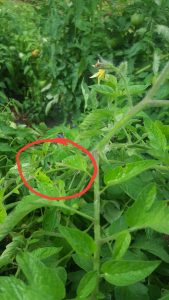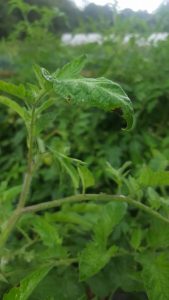– Harvest week 2 –
Today was a whirl-wind of a day; between heavy-heavy rains, large quantities of ripe fruit, and a brand new disease in the field, today was wild.
I may be a broken record: “the weather was wet all last week”, “last week was a rainy/wet one”, but the weather has truly and officially turned away from summer. Fall is truly in the air, and western Washington has lived up to it’s classic fall-time weather. As I write this, the rain is coming down in sheets and beating down everything in its path, and the forecast shows more rain in the near future. And yet, the tomato plants are pumping out many pounds of ripe and delicious fruit – I harvested nearly 60lbs of fruit today!
The harvests are fairly straight-forward but I will share with you what my process is for picking the fruit and recording the information that should be collected:
- Having all of my harvest supplies gathered, I start by walking though the plots and recording which varieties have ripe fruit, as well as anything new with the plants that may stand out to me and need further investigation.
- Once I have labeled a container with the variety and date that I am to harvest, I will harvest any ripe fruit that I see from the plants.
- Now that I have gone through the process of harvesting the fruit from all of the varieties, I will take notes on the fruit’s physical appearance, the ease of picking, and any other note-worthy information that would be special to that particular variety.
- When all of the harvestable fruit are picked and field notes are taken, I haul them all to my weighing station, separating the fruit into marketable and unmarketable, and weighing them out separately, recording the weights for individual varieties.
- Once this has all been done, and the notes and data have been taken and recorded, I will then store the tomatoes, separated by variety and clearly labeled, for future use, i.e: tasting trials, Brix readings, and personal eating.
—
The dichotomy between healthy plants and sick plants has manifested quite boldly in the fruit of said plants. While a sick plant may produce some ripe fruit, it is apparent that something has inhibited the healthy flow of water and essential nutrients to the fruit. They may appear red from a distance but upon closer inspection, I find blotchy skin that doesn’t get to the full/deep color of a healthy tomato, and a reduction in the overall size of some of the fruit. This is all to say that, although the various diseases haven’t killed the various plants, the fruit have been negatively affected and marketability % is greatly reduced.
To tie everything together a put a nice little bow on this post, I am excited and anxious to report that I believe to have found the first signs of LATE BLIGHT in the field! I am not too surprised by this revelation, in light of the recent weather patterns, but that doesn’t change the fact that it is there. I am not entirely positive in my identification and will be getting a second opinion, but if I am correct, I will know sooner than later. For the successful spread of late blight, humidity and moisture levels must stay relatively high, so if the weather quickly turned hot and dry, the disease may be slowed down. I don’t expect this to be the case. 

Late blight usually starts on the upper most branches and leaves (they are the first to come in contact with airborne spores) and will then spread fairly rapidly through a plant, especially one that is moist or wet. Not only did I see small marks on the leaves of multiple varieties, I was seeing them on the stems as well, which makes me even more confident of my identification.
Now that I am aware of the disease, I will be checking the afflicted plants daily to see what kind of spread takes place throughout the plots.
Cross your fingers so that the plants survive another 3 weeks, and keep producing fruit through the harvest period and give us some study specimens for the tasting trials!
As always, thanks for reading.

Leave a Reply